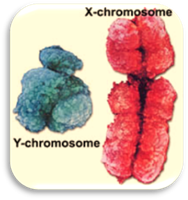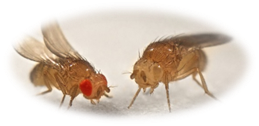HEREDITY – SEX-LINKED

In this unit, we will discuss Sex-Linked Traits.
Sex-Linked traits are carried on the X and Y chromosomes of the sex
chromosomes. The two previous crosses you learned, monohybrid and dihybrid,
dealt with the autosomes. Remember that autosomes are chromosomes 1-22. The sex
chromosomes are the 23rd pair. Also, remember that the sex chromosomes for a female are “XX”
and the sex chromosomes for a male are
“XY”. Even though sex-linked traits may be carried on the X or Y of the sex
chromosomes, most sex-linked traits are located on the X chromosome, because
the Y is shorter and holds fewer genes.
Thomas
Hunt Morgan
Visit the website below for an animation of Thomas
Hunt Morgan’s experiment with fruit flies.
http://dnaftb.org/10/animation.html
Sex Determination
Sex determination in Fruit Flies, as in humans,
results from the arrangement of sex chromosomes. Reminder, the female sex chromosomes are “XX” and the male sex
chromosomes are “XY”. As you know, chromosome pairs are separated when forming
the gametes (sperm and egg) through the process of meiosis. As a result, the
gametes that are produced have either an “X” sex chromosome or a “Y” sex
chromosome, depending on the gamete type.
|
|
Male Parent |
||
|
X |
Y |
||
|
Female Parent |
X |
XX |
XY |
|
Female |
Male |
||
|
X |
XX |
XY |
|
|
Female |
Male |
||
When a female forms gametes, the only possible
chromosomes that can be separated into two different gametes is an “X” and
another “X”, because her sex chromosome pair is “XX”. When a male forms gametes,
it is possible for one gamete to pick up an “X” chromosome and another gamete
to pick up a “Y” chromosome, because his sex chromosome pair is “XY”. Setting
up a Punnett square to show these gametes crossing displays why, on every
birth, there is a 50/50 chance of male or female. It also displays how the
father’s gametes determine the gender of the offspring, because he offers
either an “X” chromosome to a future female offspring or a “Y” chromosome to a
future male offspring.
Morgan’s Experiment
Thomas Hunt Morgan confirmed the existence of X-linked
(sex-linked) traits by crossing the eye color of fruit flies. Most fruit flies
have red eyes while a few have white eyes. Morgan originally crossed a
white-eye male with a red-eye female and the F1 generation included
all red-eye offspring of both genders just as Mendel would have predicted.
|
F1 |
Male
Fruit Fly with White Eyes |
||
|
Xr |
Y |
||
|
Female Fruit Fly with Red Eyes |
XR |
XRXr |
XRY |
|
XR |
XRXr |
XRY |
|
*Notice that the alleles for
eye color are only carried on the “X” chromosomes. Red eye (R) is dominant and
white eye (r) is recessive.
Morgan then crossed two members of this F1
generation. The F2 generation then showed the expected ratio of 3
red eye fruit flies to 1 white eye fruit fly, however, he found that the white
eye fruit flies were all male.
|
F2 |
Male
Fruit Fly with White Eyes |
||
|
XR |
Y |
||
|
Female Fruit Fly with Red Eyes |
XR |
XRXR |
XRY |
|
Xr |
XRXr |
XrY |
|
After these F2 generation results, Morgan then
concluded that the gene for eye color is carried on the “X” chromosome.
Concerning sex-linked traits carried on the “X”
chromosome, it is important to realize that males have a 50% chance of having a
recessive sex-linked trait, while females have only a 33% chance of having a
recessive sex-linked trait. In the case of fruit flies with sex-linked eye
color, males are either red-eye, XRY,
or white-eye, XrY
(1/2, 50%). Females are red-eye, XRXR
or XRXr,
or
white-eye, XrXr
(1/3 = 33%).
Terminology: The term Carrier can be used for a heterozygous female (example: XRXr). A carrier female will still exhibit
the dominant trait but “carry” the recessive trait.
Sex-Linked Cross Example
Hemophilia
is a recessive sex-linked genetic disorder that impairs the body’s
ability to clot the blood when a blood vessel is broken. We will use “H” for
the dominant allele which represents normal blood clotting. We will use “h” for
the recessive allele which represent the hemophiliac condition.
Parents: Hemophiliac Female x Normal
Male
*Little
Note: In all of the other types of hereditary crosses the
gender of the parents never matters, however, in sex-linked crosses the gender
of the parents and offspring must be made known.
1. Genotypes
of Parents: XhXh x XHY
Due to the law of segregation, the alleles will now
separate into gametes. The alleles separate with the “X” chromosome to which
they are attached.
2.
Gametes of Parents: Xh, Xh
x XH, Y
One parent’s alleles (gametes) will be placed on top of
the Punnett square. The other parent’s alleles will be placed on the side of
the Punnett square.
|
|
Xh |
Xh |
|
XH |
|
|
|
Y |
|
|
3.
Crossing the Parents’ Alleles:
Now, we will cross the two parents by first dragging the
“X”s with their allele attached, above each column, down into the two lower
boxes.
|
|
Xh |
Xh |
|
XH |
Xh |
Xh |
|
Y |
Xh |
Xh |
Next, we will drag the “X” with its attached allele,
beside one row, across into the next two boxes and then the “Y” in the same
fashion.
|
|
Xh |
Xh |
|
XH |
XH
Xh |
XH
Xh |
|
Y |
Xh Y |
Xh Y |
*Little
Note: Whenever you have a capital letter (dominant allele)
and a lowercase letter (recessive allele) together, list or write the capital letter
first then the lowercase. Hh and hH
are the same genotype, just write it as Hh.
After completing the Punnett square, we can now
determine the genotypic and phenotypic probabilities. The genotypic probability
will provide us with a calculation of the chance of having a particular
genotype. The phenotypic probability will provide us with a calculation of the
chance of having a particular phenotype. However, with sex-linked traits,
offspring can be analyzed by gender or by the overall group.
4.
Genotypic Probability (Gender-based)
Record the genotype of the upper left box of the
Punnett square (XH Xh). Then
count how many boxes out of 2 have the same genotype. Out of 2 because only two
out of the four boxes are designated for females (XX). In this cross we have a
probability of 2/2 XHXh.
We then determine the next possibility which is XhY
and count how many boxes have that same genotype. In this cross we have a
probability of 2/2 XhY.
5.
Phenotypic Probability (Offspring-based)
Phenotypic probability can be determined two ways: by
offspring or by gender. We will first look at offspring phenotype. When
considering offspring, we need to look at all four boxes, disregarding gender.
In this cross, we have a phenotypic probability of 2/4 Normal (which happens to be the two females); 2/4 Hemophiliac (which happens to be
the two males).
6.
Phenotypic Probability (Gender-based)
We will now look at gender phenotype. When considering
genders, we need to look at the two female boxes separate from the two male boxes.
In this cross, we have a phenotypic probability of 2/2 Female Carriers (remember, these females are normal, but carry
the hemophilia allele); 2/2 Hemophiliac
Males.
Unit 23
Worksheet Heredity – Sex-Linked
Click on the Quizlet
icon below to access the quizlet.com vocabulary flash cards. Review the
vocabulary before completing your assessment.
 Now answer questions 1 through 20.
Now answer questions 1 through 20.


